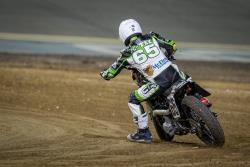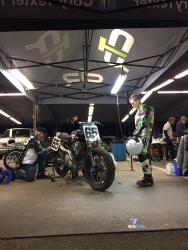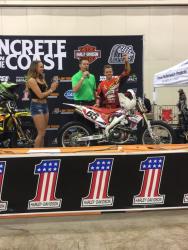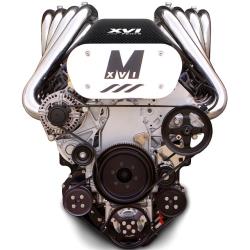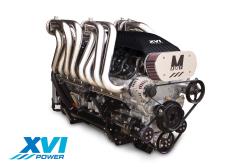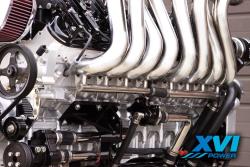Cory Texter Off to a Busy Start to the Flat Track Racing Season
- 22 mar 2017
| After a winter spent in training, bike preparation, and anxiously awaiting the new racing season, K&N-sponsored flat track racer Cory Texter is back in the saddle. The 2017 season has started with a flurry of warm-up, regional, and specialty races, as well as the first round of the American Pro Flat Track series. Here is a rundown of Texter’s early season racing. Savannah All-Star Half Mile
“A lot of fast guys come to this race and I was eager to see where I stacked up after a long off-season,” Texter said. “I felt good all day on both my Kawasaki 750 and Honda 450.”
The Super Singles class is open to any size engine as long as it is a single cylinder machine. Texter rode his Honda in the class. “I didn't get the best start, but I passed a couple guys and chased down the leader who was riding a super fast big bore 450,” said Texter. “I was close, but no cigar and finished 2nd.” The Expert Twins class main event proved to be another fast-and-furious contest with the results more to Texter’s liking. “I pulled the holeshot and put in some solid laps the first half of the race.” said Texter. “When I saw I had a large gap over the rest of the field, I put it on cruise control and sailed her home for the win. I have won a couple of races here in the fall, but this was the first spring All-Star main event I have won here.” Volusia All-Star Half Mile
“This track is extremely tough to pass on and a good start is crucial,” Texter said. “Unfortunately, in the Expert Twins heat race, I had a terrible jump and found myself in third place. I was trying all I could to make a pass for second, but the bike wasn't working the way I wanted it to. I ended up getting passed on the last lap and finished 4th in my heat race.” Getting a similar start in the Super Singles race, Texter’s competitive nature kicked in to full gear. “In the Super Singles class, I again got a terrible start, but I wasn't going to be denied twice, so I ended up [passing] five riders in my heat race to take the win,” said Texter. “We made some changes to my Kawasaki Twin and I was really eager to redeem myself in the main event, but Mother Nature decided she wanted it to rain and we were scored by the heat races,” Texter said. “I ended up 7th on the twin, but I had the fastest heat race time on the 450 and won the Super Singles class. I was bummed with the final result on the twin and not being able to try the changes we made to the bike for the main event, but it felt good to get a win on my 450.” American Flat Track Series Round 1 - Daytona TT
“I have never been to a race in my life where there were more unknowns than the Daytona TT,” said Texter. “I prepared myself and my bikes as best I could with the budget I had, but I still wasn't sure what to expect. The track was basic, but fast and technical. To be honest, I have only raced a couple of TT events over the past few years. I ride a lot of motocross, but it's still a different animal. I qualified 21st, which I wasn't pleased with.” There is a new knockout format to the qualifying in American Pro Flat Track this year, and Texter made the cut with a gutsy qualifying ride. “I battled hard and finished in 8th, which was good enough for a transfer to the main,” Texter said. “I train hard and I was really looking forward to a hard, long 25 laps.” For Texter, the Daytona TT was clear and powerful evidence that the smallest mechanical part can be the difference between a successful race effort and a DNF. “One of the biggest issues I was having all day was with my shifter. My bike was missing shifts all night long,” said Texter. “After the semi, we noticed my shifter was loose, so we swapped in a new shifter. Unfortunately on lap five in the main event, my shifter came off completely causing me to DNF.” “I was credited with 17th,” Texter said. “I was bummed about the whole deal because I was confident I could have had a solid finish, but a mechanical like that is out of my control, so it's something I can't dwell on. We learned a lot of things that will better us for the additional TT races on the schedule. On the positive, I kept it on two wheels and came out of there with a couple of points heading into a couple of race tracks I am really excited for.” Clash of the Concrete Indoor Race
“I was tired from the National the night before, but racing motorcycles is my job, so I got my bike ready and went to work,” Texter said. “There were some good riders in attendance with a good purse on the line. Harley-Davidson broadcasted the whole event on their Facebook page, which was pretty neat. I do well on these concrete indoors. I ended up winning my heat race and the main event. Although it wasn't a Grand National, it felt good to redeem myself from the night before and grab another win for my sponsors during Daytona Bike Week.” Texter is primed and ready for round two of the American Pro Flat Track season. The Georgia Short Track will be held at Dixie Speedway in Woodstock, Georgia. “Thanks to all of my sponsors for all of the support this season,” Texter said. “I know that is a cliché statement, but without all of the support, I wouldn't be able to call this my job and I am truly blessed to have a great group of supporters behind me this year.” | ||||
| | ||||
| ||||
| | ||||

